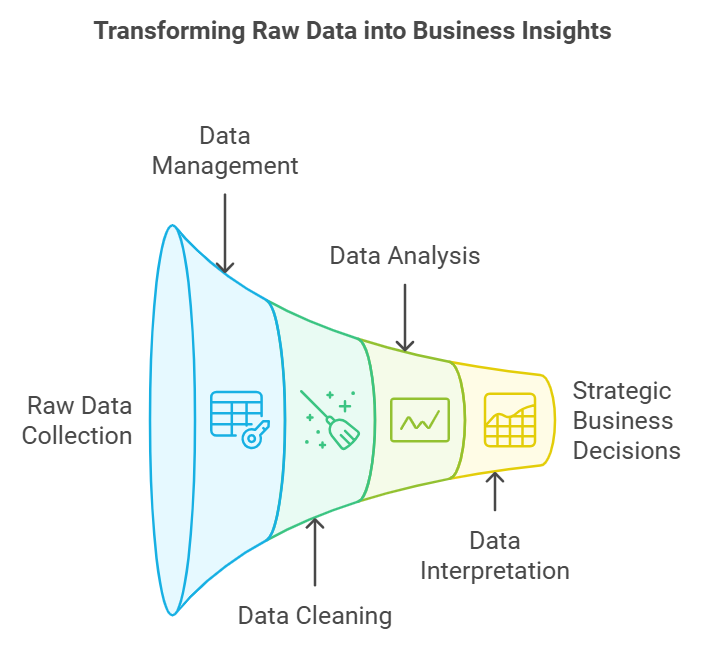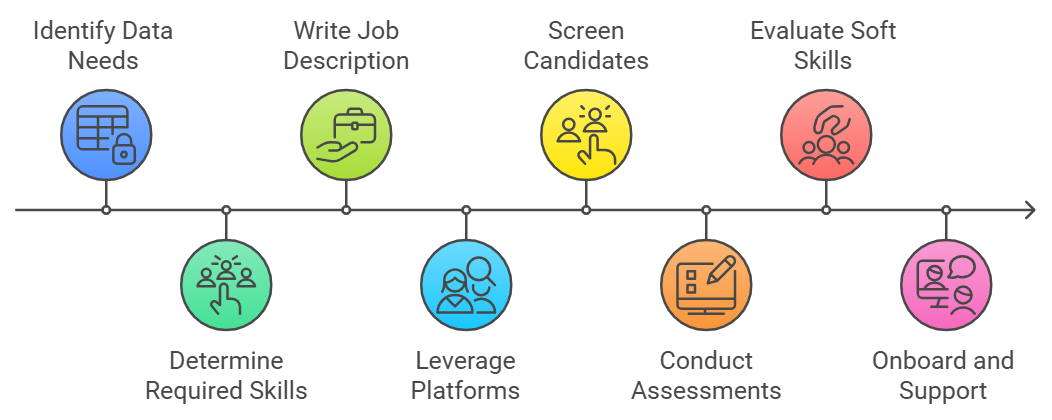
The implementation of data has become important in different types of organizations aiming at formulating better decisions and understanding the organizational processes, customers, and competition. The increase in the significance of data has become a necessity for corporations to data analyst to recruit who should be expected to extract, analyze, and report information from large databases. By 2024, with most organizations’ operations being more technical and informed by data, the right data analyst to recruit will be a key component in the success of any business venture.
This article, it indicates how businesses can follow these step by step to hire a data analyst, what the work of the data analyst entails, and the qualifications that one should look for when recruiting data analytics jobs. We will discuss some of the best channels to get the right talent and how Rozgar.com can help in the process.
Why Data Analyst Hiring is Necessary in 2024
With organizations today leveraging data to support their decision-making as well as manage their operations and customers, data analysts are among the most desirable professions in the current job market. Regardless of the areas to be developed in the sense of internal operations or perceived by clients, data analysts offer the knowledge required to act accordingly.
- Growing Demand for Data Analysts: This is expected to be the case in 2024 when different healthcare industries, financial institutions, online retail shops, and manufacturing industries among others will be in need of data analysts to handle big data, AI, and machine learning.
- Business Impact: A professional data analyst is capable of performing analysis on data collected that can help organizations discover patterns and make predictions of outcomes of interest and the possibilities of increasing cost savings or enhancing profitability.
Key Responsibilities of a Data Analyst

Hiring a data analyst is a decision that every organization should make willingly after knowing all the roles of a data analyst. The data analyst job role does not only entail numbers and figures, but also it entails an ability to turn this data into a tool for any business.
1. Data Collection and Management
A data analyst gathers data from a wide range of areas including databases, customer management systems, and third-party vendors. They also guarantee that data is saved safely, and it’s well arranged, if not, it can be arranged easily.
- Data Sources: This could be what it concerns structured data, fixed data such as the number of sales, and/or unstructured data such as customer reviews.
- Importance: The credibility of the collected data determines the quality of insight produced.
2. Data Cleaning and Preparation
Data isn’t always perfect. Data cleaning actually takes up a significant portion of the data analyst job role which includes deletion of duplicate values, missing values, and other format inconsistencies.
- Why It Matters: The key thing about data is that it must be as clean and well-organized as possible to draw the right conclusions.
3. Data Analysis and Interpretation
Once the data is cleaned the analyst proceeds with an exploratory data analysis (EDA) to discover the relationships or patterns. Hypothesis-related data analysis is done by statistical tools and software such as Python, R, or SQL.
- Tools Used: Data analysts mostly display a summary of their results to key decision-makers using tools such as Tableau, Power BI, or MS Excel.
- Key Role: The information they present is valuable for decision-makers who use it to design strategies, improve operational effectiveness, or create new goods.
4. Reporting and Communication
This shows that data analysis cannot be complete unless the results are well expressed or communicated. Another major, often fundamental task within the data analyst job role is presenting the results, using tools such as reports, dashboards, and visuals that are easily understandable by the technical non-report users.
- Why It’s Important: The purpose of clear reports is so that businesses can take the appropriate action based on the obtained information, any aspect from customer service, product, or costs.
Important Steps to Find and Hire Data Analyst

1. Identify Your Data Needs
If you are considering an external search to fill the data analytics position, make sure that you are very specific about the questions you need to answer through the use of data first. Need customer insights for marketing or operational optimization, perhaps trying to fine-tune supply chains? This will enable you to know the kind of data analytics professionals to employ in order to meet your objectives.
- Data-Driven Goals: Need risk management and prediction analytics? But do you need straightforward submission of data, for instance? It will determine if you are in need of a general data analyst or a particular one who has some particular skills.
2. Determine the Required Skills
After you’ve described the data that you require, make a list of the competencies required for the position of data analyst. Depending on the complexity of your data, the skills required can vary:
- Technical Skills: Technical skills, which include Python, R, SQL , MS Excel, and any data visualization tools such as Power BI, or Tableau.M
- Analytical Skills: Knowledge of statistics, data mining, business intelligence , and predictive modeling.
- Soft Skills: And, presentation is important as a data analyst has to disseminate information to non-technical audiences.
3. Write a Detailed Job Description
There is no better way of doing this than developing a good and standard job description. It is also important that this demonstrates the key accountabilities, personal attributes, and competencies required for the data analyst job.
- Job Responsibilities: Some of these activities may be data cleaning, data visualization, reporting, and analyzing data together with other departments within an organization.
- Required Qualifications: Depending on your business requirements, you can go for degrees in statistics, mathematics, or data science, google data analytics certification, or course ra from Coursera.
4. Leverage the Right Platforms to Find Talent
In order for you to be able to hire for your data analytics positions, you will have to put your job openings where data analysts are searching for jobs. This is depending whether you need full-timers, part-timers or contractors because you find general job websites, industry-specific job sites, and even freelancer websites.
- Job Boards: By posting the data analyst job role on internet platforms such as LinkedIn, Indeed, Rozgar.com.
- Freelance Platforms: If you are looking for temporary project-based analysts then websites like Upwork or Freelancer may be the right places to look.
5. Screen and shortlist candidates
Probably the best way to choose what students apply is to look at applications and then set criteria in order to select some candidates. In a perfect world, you need to look for candidates with the correct balance, overall experience, technical knowledge, and soft skills.
- Review Portfolios: A majority of data analysts will have portfolio samples of their previous projects. Future instantly reviews sample data analysis, visualizations, and several reports to determine to what extent the candidate is capable of converting data into knowledge.
- Check for Certifications: Industry certifications assure that a candidate has the technical competencies needed to meet the demands of your data analytics vacancies.
6. Conduct Technical Assessments
If you want to be very sure that the candidate can actually do what you expect them to do, then it might be a good idea to give the candidate a technical test or exercise. This could be something as simple as using the sample dataset to look at the data and run predictive analysis or create a more detailed dashboard to track main trends.
- Why It’s Important: By giving such technical tasks, you are not only testing whether a candidate has a grasp of technicalities that are necessary when it comes to business insights but also the ability of the candidate to distill these insights accurately.
7. Evaluate Soft Skills and Cultural Fit
It is important to fully utilize methodological competencies but leaves have not forgotten to emphasize the role of communications, collaboration, and decision-making. Depending on the specific job, an ideal data analyst should have a talent for presenting the conclusion in a form that will encourage change.
- Key Questions: Using questions and answers, you should also ask how the candidate has collaborated with other functional teams and the type of data they have used to address certain business needs.
8. Onboard and Support Continuous Learning
However, hiring a data analyst is only the first step, the next important step is onboarding. Equip them with what they need to do their work right from the start on cross-functional teams. Also, read more as the field of data analytics is dynamic, and new information is developed constantly.
- Continuous Development: As a form of encouragement the possibility is recommending enrollment in additional data analytics classes or attending trade shows.
Platforms to Find and Hire Data Analysts
- LinkedIn: LinkedIn is one of the biggest professional platforms and it is perfect for reaching out to experienced data analysts, connecting, and ad posting.
- Rozgar.com: A professional job site, Rozgar.com is a great way to source talented professionals to fill various data analytics positions rapidly.
- Specialized Platforms: Other platforms that can provide equally good candidates are Kaggle and, to some extent, GitHub, the platforms with a strong focus on data analysts experienced in machine learning and big data.
| Latest Category Jobs | ||
|---|---|---|
| Job Information | Apply Job | |
MANAGER/SENIOR MANAGER- DATA SCIENTIST(6-11 years) | ||
Ai Scientist(0-4 years) | ||
Business Advisor - A(2-5 years) | ||
Hiring For Business Analyst(2-4 years) | ||
Business Advisor - B(2-6 years) | ||
AI/ML Engineer(6-10 years) | ||
Conclusion
To find and hire a data analyst in 2024 involves a strategic approach starting with an understanding of your particular data requirements through to technical competencies and values alignment. In today’s world, information is the new currency, meaning you need to have a data analyst in your corner if you want to succeed. How about trying a platform, such as Rozgar.com, that will help to find qualified candidates for your data analytics openings? It is quite possible to find the right data analyst for your business if you follow the right approach.
Frequently Asked Questions
Generally, for the role, you should look for expertise in tools like SQL, Python, R, and data visualization tools – Tableau or Power BI, and good analytical and communication skills.
For such positions, you can advertise your position on www.linkedin.com or www.indeed.com, www.rozgar.com, or if your position is freelance in nature, then www.upwork.com.
The data analyst job description requires the individual to gather, clean, process, and understand data in a way that can be used to support decisions made in an organization.



